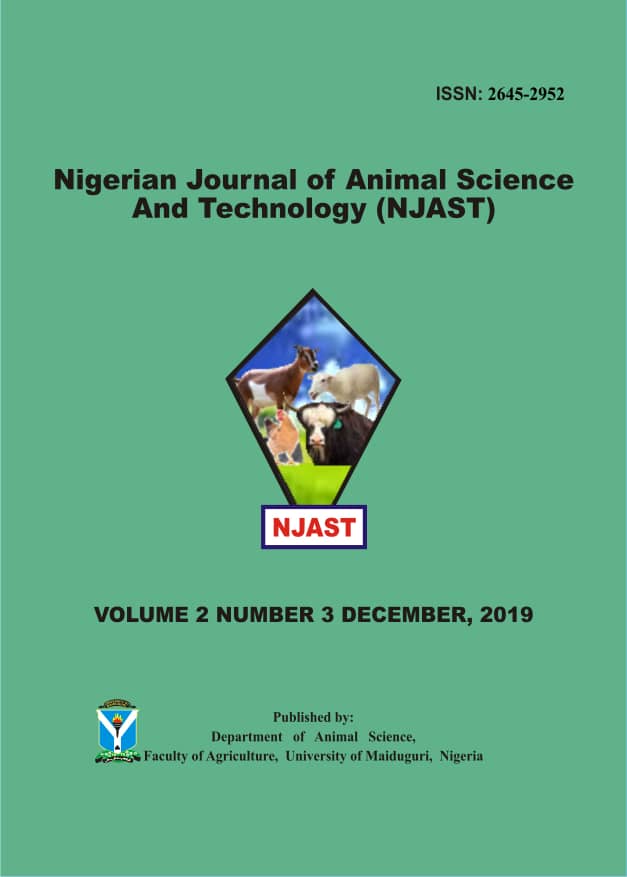Carcass Characteristics, Organ Proportion and Economics of Broiler Chickens Fed Graded Levels of Processed Manihot esculentum crantz (var. Umucass 36) Cassava Composite Meal
Abstract
One week old one hundred and fifty (150) Arbor Acre broiler chickens were used to determine the
effect of feeding cassava composite meal as replacement for both maize and soya bean in broiler
chickens diets, on their carcass characteristics, organs proportion and economics of production.
The harvested cassava roots were washed, peeled, grated, dried and toasted into ‘gari’, the leaves,
petioles (which formed the leaf meal) and tender stems were also chopped and oven dried. The
cassava composite meal (CCM) was a mixture of the root meal, foliage meal and the tender stem
meal. The birds were randomly assigned to five treatment diets replicated into three with ten birds
per replicate in a Completely Randomized Design. Five diets were formulated and designated D1
(control) to D5. Anti-nutrients like Hydrogen cyanide and Pytate did not follow a particular
pattern while Tannin and Trypsin inhibitor decreases with increasing levels of CCM. The antinutrients
in the diets were within the tolerable level for broiler chickens. Broilers on diet D2 having
5% inclusion level of CCM was better in carcass characteristics. Diets D3, D4 and D5 with higher
inclusion level of CCM had heavier weights of heart, liver, gizzard, small intestine and abdominal
fat compared to the control diet. Broilers on Diet D2 were the costliest to produce but gave the
best revenue and gross margin. From the fore going it could be concluded that five percent level
of inclusion UMUCASS 36 composite meal can replace both maize and soybean for optimal
performance of broiler chickens.
Downloads
References
Aina, A.B.J. (1990). Replacing maize with cassava peels in finisher rations of cockerels: The effects of cut-up pieces of the eviscerated carcass. Nigerian Journal of Animal Production 17:17 – 2 2.
Akanji, A. M., Ologbobo, A. D., Emiola, I. A., Adedeji, O. S. (2003). The effect of various processing on haemagluttinin and other anti-nutritional factors in jackbean. In: Proceedings of the 28th Annual conference of the Nigeria Society for Animal Production, IAR&T, Ibadan. Pp 189 – 193.
Akinfala, E. O., Matanmi, O. and Tinuala, J. A. (2011). Nutrient characterization of cassava plant meal and its utilisation by broiler chickens in the tropics. Livestock Research for Rural Development. 23: (11).
Akinmutimi, A. H. (2004). Evaluation of sword bean (Canavalia gladiata) as an alternative feed resource for broiler chicks. Ph.D. Thesis, College of Animal Science and Animal Health, Michael Okpara University of Agriculture, Umudike. Pp 4 – 17.
Apata, D.F. and Babalola, T.O. (2012). The use of cassava, sweet potato and cocoyam, and their by-products by non-ruminants. International Journal of Food Sciences and Nutrition 2(4):54–62.
Atuahene, C.C., Don Koh, A. and Nkansah-dako, P. (1986). Effect of raw cotton seed meal on the performance, carcass characteristics and certain blood parameters of broiler chickens. Journal of Animal Production Resource 6 (2): 107-114
Cassava Master Plan (2006). A strategic Action Plan for the Development of Nigeria Cassava Industry. In: Prepared within the framework of the Nigeria country service framework and in cooperation with the presidential initiative on cassava. Pp 1-105.
Cowieson, A. J and Bedford, M. (2009). Reducing the anti-nutrient effect of phytate. Feedmix. World Poultry Science Journal, 65 (3): 609-624.
FAO (2004). A cassava industrial revolution in Nigeria. In: Agriculture and consumer protection.
Iwere Ted (2013). IITA, Partners advocate road map for cassava residue in feeds.
Moreki, J. C, Dikeme, R and Poroga, B. (2010). The role of village poultry in food security and HIV/AIDS mitigation in Chobe District of Botswana. Livestock Resource and Rural Development, 22, Article #5.
National Root Crops Research Institute (2017). National Root Crops Research Institute, Umudike, Nigeria. Agro-Metrologic Unit.
Ngiki, Y. U, Igwebuike, J. U. and Moruppa, S. M. (2014). Utilization of cassava products for poultry feeding: a review. International Journal of Science Technology; 2 (6):48-59.
Nkwocha, G.A., Anukam, K.U. Oguoma, O.N. and Nkwocha. V.I. (2010). Animal agriculture as panacea for increased protein intake in Nigeria. African Journals online 6, (3) North America: Exotic Animal Practice. 2:143. W.B. Saunders Company.
Ojewola, G. S. and Longe, O. G. (1999). Comparative response and carcass composition of broiler chickens fed varying protein concentration. Proceedings of 4th Annual Conference of Animal Science Association of Nigeria, Pp. 69 – 72.
Ojewola, G.S., Okoye, F.C. and Ukoha, A.O. (2005). Comparative utilization of three animal protein sources by broiler chicken. International Journal of Poultry Science, 4 (7): 462-467.
Onyimonyi. A and Ugwu, S.O.C. (2007). Bioeconomic indices of broiler chicks fed varying ratios of cassava peel/bovine blood. International Journal of Poultry Science 6 (5): 318-321.
Osei, S. A and Duodu, S. (1988). Effect of fermented cassava peel meal on the performance of broilers. British Poultry Science, 29: 671-675.
Pachaeco-Dominguez, W. (2011). Evaluation of trypsin inhibitors level and particle size of expeller extracted soy meal on broiler performance. MSc. Thesis. North Carolina State University Raleigh, North Carolina.
Tang, D. F, Ru, Y. J., Song, S. Y, Mingan, C. and Paul, A. I. (2012). The effect of cassava chips, pellets, pulp and maize based diets on performance, digestion and metabolism of nutrients for broilers. Journal of Animal and Veterinary Advances, 11 (9):1332 – 1337.
Vohra, P., Katzer, F.H and Joslyn, M.A. (1966). The growth depressing and toxic effects of tannins to chicks. Poultry Science, 46: 132-142.



